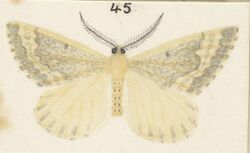Biology:Asaphodes nephelias
| Asaphodes nephelias | |
|---|---|

| |
| Male | |
| Scientific classification | |
| Domain: | Eukaryota |
| Kingdom: | Animalia |
| Phylum: | Arthropoda |
| Class: | Insecta |
| Order: | Lepidoptera |
| Family: | Geometridae |
| Genus: | Asaphodes |
| Species: | A. nephelias
|
| Binomial name | |
| Asaphodes nephelias (Meyrick, 1883)[1]
| |
| Synonyms[2] | |
| |
Asaphodes nephelias is a moth in the family Geometridae.[2] It is endemic to New Zealand and has been observed in the South Island. The preferred habitat of this species is alpine tussock grasslands above native forest and in wetlands. The adults of this species are on the wing from January to March and are day flying. The female has brachypterous wings.
Taxonomy
This species was first described in 1883 by Edward Meyrick using specimens collected at Arthur's Pass at 4600 ft in January and named Larentia nephelias.[3] Meyrick gave a fuller description later in 1884.[4] George Hudson discussed the species in his 1898 volume New Zealand moths and butterflies and referred to it as Xanthorhoe nephelias.[5] Hudson discussed and illustrated this species under that name in his 1928 publication The butterflies and moths of New Zealand.[6] In the same publication Hudson synonymised Xanthorhoe subflava with this species.[6] In 1971 J. S. Dugdale placed this species within the genus Asaphodes.[7] In 1988 Dugdale confirmed this placement.[2] The male lectotype is held at the Natural History Museum, London.[2]
Description
Meyrick first described this species as follows:
Pale whitish-grey, slightly ochreous ; a discal dot, sinuate line beyond middle, and two rows of cloudy spots before hind margin dark fuscous.[3]
Meyrick gave a fuller description in 1884 and stated:
Male, female. — 32-34 mm. Forewings moderate, in female narrower and more elongate, hindmargin rounded; pale whitish-grey, slightly ochreous-tinged ; an indistinct suffusion of dark fuscous scales before middle ; a small dark fuscous discal dot ; a rather irregular cloudy dark fuscous line beyond middle, sinuate beneath costa, shortly angulated in middle ; a very faint stria beyond this ; a hindmarginal band composed of two rows of cloudy partially confluent dark fuscous spots, separating on costa : cilia pale whitish-grey. Hindwings moderate, in female narrower, hindmargin rounded ; ground-colour as in forewings, with a few grey scales posteriorly.[4]
The female of this species is brachypterous.[7]
Distribution
This species is endemic to New Zealand and has been collected in Arthur's Pass and Mount Arthur.[1][5] This species has also been collected in Central Otago including on Ben Lomond, Nevis Valley as well as at Danseys Pass.[8][9]
Behaviour
The adults of this species are on the wing from January to March and are day flying.[6][9]
Habitat
This species is found in alpine tussock grasslands above native forest.[6] It has also been observed in wetlands in Otago at the Danseys Pass as well as the Nevis Red Tussock Fen.[8][10]
References
- ↑ Jump up to: 1.0 1.1 "Asaphodes nephelias (Meyrick, 1883)". https://www.nzor.org.nz/names/d3c41035-4881-4165-a9e2-b4e16432c759.
- ↑ Jump up to: 2.0 2.1 2.2 2.3 , pp. 173-174, Wikidata Q45083134
- ↑ Jump up to: 3.0 3.1 Meyrick, Edward (1883). "Monograph of New Zealand Geometrina" (in en). New Zealand Journal of Science 1: 526–531. https://biodiversitylibrary.org/page/41866182.
- ↑ Jump up to: 4.0 4.1 , pp. 78, Wikidata Q109615359
- ↑ Jump up to: 5.0 5.1 , pp. 61, Wikidata Q19073637
- ↑ Jump up to: 6.0 6.1 6.2 6.3 , pp. 121, Wikidata Q58593286
- ↑ Jump up to: 7.0 7.1 , Wikidata Q64006453
- ↑ Jump up to: 8.0 8.1 , pp. 410, Wikidata Q109420935
- ↑ Jump up to: 9.0 9.1 , Wikidata Q110318301
- ↑ "Nevis Red Tussock Fen" (in en). https://www.orc.govt.nz/managing-our-environment/water/wetlands-and-estuaries/central-otago-district/nevis-red-tussock-fen.
Wikidata ☰ Q41804945 entry
 |



